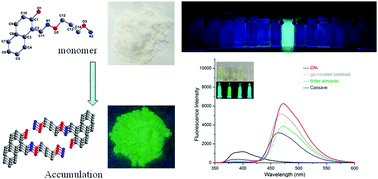A new salamo-based colorimetric and fluorescent turn-on sensor with aggregation-induced emission for the rapid and highly sensitive detection of cyanide in real samples†
Abstract
A new, simple and easy-to-manufacture highly selective and sensitive dual-mode sensor A1, is used for CN− colorimetric and fluorescence detection. Interestingly, the solid powder of sensor A1 emits a strong green fluorescence, and has aggregation-induced emission properties. Single crystal diffraction analysis results prove that the generation of AIE properties is based on the J-aggregation mechanism. Simultaneously, A1 showed high selectivity and sensitivity to CN− in many interfering anions. The sensing mechanism of cyanide is carried out by deprotonation of the –OH group by the cyanide ion, and has been confirmed by spectroscopic studies, 1H NMR spectroscopy, Job's plot analyses and DFT calculation. The practicality of the sensor has been well proven by filter paper strips and small molecule smart fluorescent display materials. In addition, the sensor is used to detect cyanide in food materials (such as germinated potatoes, cassava and bitter almonds) with satisfactory results. The most important thing is considering the colorimetric and fluorescent dual modes, the ultra-fast response, excellent selectivity and recyclability that demonstrate its excellent value in practical applications.



 Please wait while we load your content...
Please wait while we load your content...